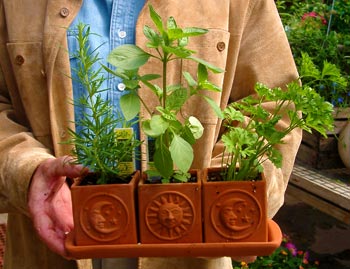Fresh herb gardening in winter
Fresh herbs are a great way to bring life to the doldrums of winter, use fresh flavors in cooking, and practice some Smart Gardening techniques.
 If you missed the opportunity to bring your garden herbs indoors, plan to start some from seed to enjoy during the winter months. Depending upon the herbs you select, some can be transplanted into your garden next year or you can choose to container-garden with herbs year-round.
If you missed the opportunity to bring your garden herbs indoors, plan to start some from seed to enjoy during the winter months. Depending upon the herbs you select, some can be transplanted into your garden next year or you can choose to container-garden with herbs year-round.
There are many different kinds of herbs to grow and enjoy. Each of them can be produced using different methods. Some are best propagated by division, which means separating a part of the entire plant either from the garden or a pot, and replanting it. Others can be grown by cutting a portion of the growing plant and replanting it. Seed production is a more common method that you can use to grow garden favorites like basil, parsley, cilantro, oregano and sage.
Select fresh seed and a well-drained soilless mix to sow them in. Be sure to plant the seeds at the proper depth; smaller seeds require a shallow planting depth. You will want to maintain a constant humidity for seed germination, so apply a plastic cover to the pot or flat you have seeded. Remove this once your seedlings emerge and make sure there is adequate air movement while keeping the surface of the media moist. Follow the temperature requirement necessary for seed germination; for most, it will be 60 degrees.
High light is important for seedlings as well as more mature plants, but be careful they do not burn. Herbs will require six hours of direct light, so if you have a south window, you could place them there. You can also place seedlings under two 40-watt white fluorescent bulbs for 14-16 hours. Use a combination of cool and warm bulbs to get a broad light spectrum. Room temperature for herbs needs to be at least a 65- to 70-degree day and a 55- to 60-degree night temperature. Be sure to monitor the temperature near windows as it may differ from the actual room temperature.
Be sure that the soil remains well-drained and that your container has a hole for excess water to drain out. Allow adequate air flow between your herb plants by placing containers far enough apart; this helps to decrease the chance of fungal diseases.
Once your herbs reach 6 inches, you can begin to harvest some of the fresh leaves. Be sure some leaves remain if you want the plant to continue to live. If any stems start to lengthen or stretch, pinch them back just above a leaf. This encourages branching, so you will get a bushier plant with more leaves. Oregano and sage are hardy perennials, so you will be able to plant them out in the garden permanently next summer.
Enjoy the flavors of your fresh herbs and consider researching additional ways to preserve herbs. For more tips on using and harvesting fresh herbs, please see Michigan State University Extension’s Michigan Fresh website.
For more information on a wide variety of Smart Gardening topics, visit the Gardening in Michigan website at www.migarden.msu.edu or contact MSU’s toll-free garden hotline at 1-888-678-3464.
Photo credit: Rebecca Finneran, MSU Extension



 Print
Print Email
Email

